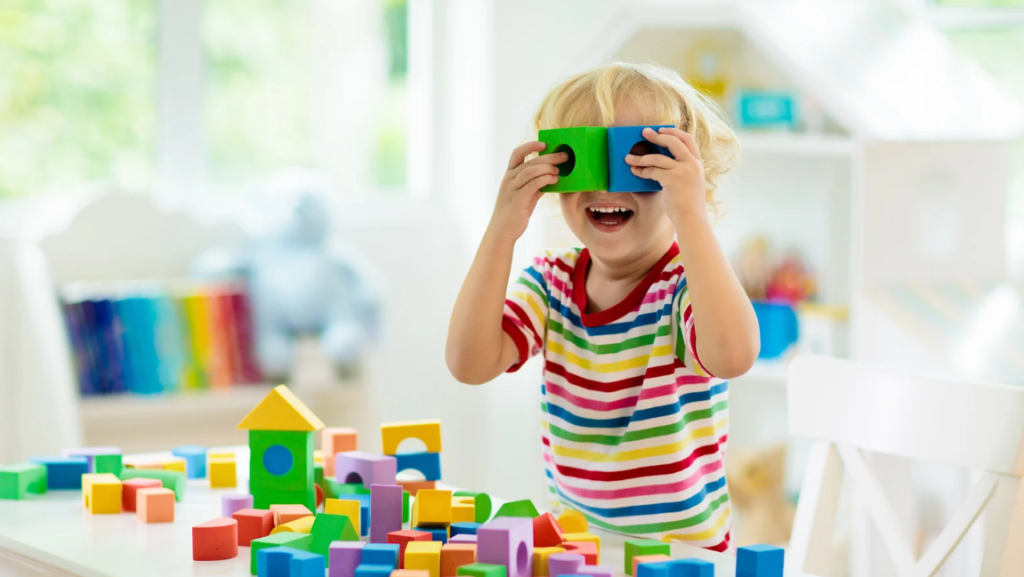
Creativity is the spark that lights up the world. It is the magical force that inspires artists to create masterpieces, inventors to come up with groundbreaking ideas, and entrepreneurs to build thriving businesses. But creativity is not just reserved for the few exceptional individuals who possess it naturally. Every child is born with the potential for creativity, and it is up to us as parents to nurture and guide this gift.
Whether a stay-at-home mom or a working parent, you can take simple steps in your daily routines to encourage your preschool-age child to think outside the box, explore new ideas, and express themselves innovatively. This article will explore the definition of creativity and the importance of fostering it in children. We will also provide 10 actionable steps you can take today to help your child unlock their creative potential.
What is Creativity?
Creativity is a captivating and multi-faceted concept that goes far beyond the confines of artistic expression. In its essence, creativity is a powerful ability that encourages individuals to think outside the box, explore new possibilities, and generate original ideas.
Creativity encompasses various forms of expression, including art, music, writing, problem-solving, and entrepreneurship. It is not limited to a select few but rather a skill that can be fostered and developed in all individuals, including children.
Why Creativity is Essential?

In the exciting world of preschoolers, fostering creativity isn’t just about playtime; it’s about shaping their growing minds and nurturing their overall development. Here’s why igniting the spark of creativity in your little ones is essential:
- Boosted Brain Power: Creative activities have been shown to improve cognitive abilities. Engaging in music, art, and other imaginative pursuits can strengthen the connections between different parts of the brain. This boosts cognitive function and enhances learning capabilities, setting your child up for success.
- Emotional Well-being: Creative expression positively impacts your child’s mood and well-being. Drawing, for example, can help kids calm down and process distressing emotions. When fully absorbed in a creative project, kids experience joy and happiness, contributing to their overall flourishing.
- Enhanced Problem-Solving: Encouraging creativity in preschoolers nurtures their problem-solving skills. When children think creatively, they learn to approach challenges with innovative solutions. This builds child’s critical thinking abilities, helping them solve problems effectively as they grow.
Teaching children to be creative is vital for their emotional well-being and brain health. But finding a starting point can be challenging. Discover nine helpful tips to nurture your child’s imagination and foster creativity.
10 Actionable Steps to Foster Creativity in Your Kids
Creativity is like a beautiful flower waiting to bloom in your child’s imagination. As a mom, you have the power to nurture and cultivate that creativity, providing them with a solid foundation for lifelong learning and expression. Here are ten actionable steps to foster creativity in your kids:
1. Allow Time for Unstructured Play

In today’s fast-paced world, carving out moments of unstructured play for your preschool-age child is crucial. Unstructured play refers to free play, where children have the freedom to explore, create, and imagine without specific rules or guidelines. This type of play is essential for nurturing their creativity and fostering a wide range of developmental skills.
In order to incorporate unstructured play into your child’s routine, consider the following tips:
- Create a safe and open play environment: Designate a dedicated play area where your child can freely explore and engage in imaginative play. Ensure it’s a safe space with age-appropriate toys, materials, and ample room for movement.
- Provide open-ended toys: Choose toys that allow for open-ended play and don’t have predetermined functions. Building blocks, dolls, art supplies, and dress-up costumes are excellent choices as they encourage creativity and flexibility.
- Limit structured activities: While structured activities have their place, it’s important not to overload your child’s schedule with too many organized programs or classes. Balance their routine with plenty of free playtime to encourage unstructured exploration.
- Allow boredom: Don’t be afraid of boredom! Boredom can be a catalyst for creativity. When children are given the space and time to experience moments of boredom, they are motivated to come up with their solutions and engage in imaginative play.
2. Ask Your Child Open-ended Questions
Asking your child open-ended questions effectively spark their creativity and encourages them to think critically.
Instead of simply asking yes or no questions, try probing with open-ended questions that prompt your child to think and come up with creative answers. For example, instead of “Did you have a good day at school?” ask, “What was your favorite part of the day?” This allows your child to think about what they enjoyed or what sparked their curiosity.
You can also ask hypothetical questions such as, “What would happen if you could fly?” or “If you could go on a trip anywhere in the world, where would you go and why?” This opens possibilities and encourages your child to use their imagination while developing problem-solving skills.
By asking open-ended questions, you’re promoting your child’s ability to think critically and creatively. These skills are essential to become innovative and resourceful individuals who approach problems with creativity and curiosity.
3. Provide Exposure to Different Forms of Art and Culture
Expose your child to various art forms, such as music, literature, visual arts, dance, and theater. Take them to museums, galleries, concerts, or performances. Expose them to different cultures through food, travel, or celebrations. This provides opportunities for them to develop a rich understanding of the world around them and to draw inspiration from different sources.
Encourage your child to experiment with different art forms at home. Provide them with paints, clay, crafts, or musical instruments. This allows them to explore their creativity and develop their skills while expressing themselves creatively.
Introduce your child to stories from different cultures through books, storytelling, or film. This broadens their perspectives and encourages them to think critically about different belief systems, customs, and traditions.
4. Create a Designated Space for Creativity

Designating a specific space for creativity can encourage your child’s imaginative play and foster creativity.
- Set aside a designated area where your child can freely explore their creativity. This can be a corner of their bedroom, a playroom, or even a small table in the living room. Make sure it’s a comfortable and inspiring space, with materials easily accessible.
- Fill the space with art supplies, books, musical instruments, or building blocks. Provide a variety of materials that cater to your child’s interests and allow them to experiment and create freely.
- Encourage your child to spend time in their creative space regularly. Let them know it’s a special area where they can let their imagination soar and pursue their artistic passions.
Creating a dedicated space for creativity gives your child the freedom to express themselves and fosters a sense of ownership over their creative endeavors. This space becomes a sanctuary for their imagination to thrive.
5. Limit Screen Time and Explore Nature Together
Set limits on the amount of time your child spends on screens. Encourage them to engage in activities that promote creativity, such as drawing, reading, or playing outdoors. This allows their imagination to run wild and helps them develop problem-solving skills.
Explore nature together by going for hikes, camping trips, or visits to a park. Observing the world around them can spark your child’s curiosity and imagination. They may discover something new about the environment, plants, or wildlife that can inspire them in their creative endeavors.
Encourage your child to create imaginative play outdoors. They can build with natural objects, create art with sticks and rocks, or invent outdoor games. This helps them develop creativity
and problem-solving skills while enjoying fresh air and exercise.
6. Collaborate on Projects Together
Collaborating with your child on projects is a great way to foster creativity and promote teamwork and problem-solving skills.
- Choose a project you and your child are interested in, such as building a birdhouse, creating a family photo album, or writing a story together. This shared experience encourages creativity and allows you to bond with your child.
- Discuss ideas and brainstorm together. Encourage your child to contribute their thoughts and opinions. This shows them that their ideas are valued and fosters their creative thinking.
- Divide tasks and work together to achieve the project goal. This promotes teamwork and teaches your child about collaboration and compromise.
- Provide guidance and support, but allow your child to take the lead and make their own decisions. This empowers them to be independent thinkers and problem solvers.
7. Offer Real-World Problem-Solving Opportunities

Nurturing your child’s creativity goes beyond artistic endeavors. Providing them with real-world problem-solving opportunities cultivates their critical and creative thinking skills. Encourage them to tackle age-appropriate challenges and celebrate their ingenuity.
For instance, involve them in planning and organizing a family event. Let them brainstorm ideas, make decisions, and find solutions to logistical problems. This exercise hones their problem-solving skills while empowering them to express their creativity.
Another example is setting up a simple science experiment at home. Encourage them to hypothesize, experiment, and draw conclusions. This hands-on approach sparks their curiosity and encourages them to think creatively to find solutions.
8. Read and Tell Stories
Reading and telling stories to your child is a wonderful way to foster creativity and ignite their imagination. Choose a variety of books that span different genres and themes to expose them to diverse narratives.
For instance, read fairy tales and encourage your child to reimagine alternative endings or create their characters. This allows them to exercise their creativity while engaging with the story.
Encourage storytelling sessions where you and your child take turns inventing stories. This interactive experience stimulates their imagination, language skills, and narrative abilities.
You can also provide them with blank books or journals to write and illustrate their stories. This empowers them to express their unique ideas and encourages their creativity to flourish.
9. Celebrate Their Unique Ideas and Creations
One of the most powerful ways to foster creativity in your child is by celebrating their unique ideas and creations. Encourage them to explore their interests and express themselves freely.
For example, if your child builds a magnificent tower out of blocks, take the time to appreciate their accomplishment. Display their artwork proudly on the fridge or create a special gallery wall to showcase their creativity.
They listen attentively and show genuine enthusiasm when they share their imaginative stories or inventions. Encouraging their ideas nurtures their confidence and inspires them to continue thinking outside the box.
10. Be a Creative Role Model

As a parent, you have a tremendous impact on your child’s development. You inspire and encourage their creative journey by being a creative role model.
Engage in creative hobbies or pursuits yourself, such as painting, writing, or cooking. Let your child see you immersed in these activities and share your passion with them. Collaborate on projects, whether creating artwork or designing a garden.
Demonstrate creativity in everyday activities too. Encourage innovative problem-solving, explore new ideas, and embrace mistakes as learning opportunities. By being a creative role model, you show your child that creativity is valuable and enjoyable, inspiring them to think creatively in all aspects of their lives.
Final Thoughts
Fostering creativity in your child is a journey that holds immense value. By implementing the actionable steps mentioned above, you can unlock their creative potential and set them on a path to success. Baby Steps, a leading provider of Infant Care, Daycare, and Preschool, supports you in nurturing your child’s creativity. We hope this article has provided practical tips to inspire and foster creativity in your little one. Embrace their unique ideas, provide them with diverse experiences, and be creative role models. Together, let’s empower our children to think outside the box and embrace the wonders of their imagination.

